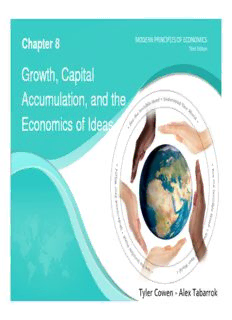
Growth, Capital Accumulation, and the Economics of Ideas Growth, Capital Accumulation, and the ... PDF
Preview Growth, Capital Accumulation, and the Economics of Ideas Growth, Capital Accumulation, and the ...
MODERN PRINCIPLES OF ECONOMICS Chapter 8 Third Edition GGrroowwtthh,, CCaappiittaall AAccccuummuullaattiioonn,, aanndd tthhee EEccoonnoommiiccss ooff IIddeeaass Outline (cid:1) The Solow Model and Catching-Up Growth (cid:1) The Investment Rate and Conditional Convergence (cid:1) New Ideas and Cutting-Edge Growth (cid:1) The Economics of Ideas (cid:1) The Future of Economic Growth 2 Introduction (cid:1) In 2010: • U.S. GDP per capita grew by 2.3%. • China’s GDP per capita grew by 10%. (cid:1) The U.S. has never grown as fast as the Chinese economy is growing today. (cid:1) China is growing much faster than the U.S. because: • The U.S. economy is on the cutting edge. • The Chinese economy is catching up. 3 Definition Cutting-edge growth: Growth due to new ideas. Catching-up growth: Growth due to capital accumulation. 4 The Solow Model and Catching-Up Growth (cid:1) The Solow model begins with a production function. (cid:1) The total output of an economy (Y) depends on: • Physical capital (K) • Human capital, or education x Labor (eL) • Ideas (A) (cid:1) A production function expresses a relationship between output and the factors of production: Y = F(A,K, eL) 5 The Solow Model (cid:1) If we assume that A, e, and L are constant, then we can simplify our expression for output as: ( ) Y = F K (cid:1) More capital (K) should produce more output (Y) but at a diminishing rate. • Because L is constant, an increase in K always implies an increase in the amount of capital per worker, K/L, and an increase in Y is also always an increase in output per worker, Y/L. 6 Self-Check Catching-up growth is growth due to: a. New ideas. b. Capital accumulation. c. Adoption of new technologies. Answer: b – capital accumulation. 7 Definition Marginal product of capital: The increase in output caused by the addition of one more unit of capital. The marginal product of capital diminishes as more and more capital is added. 8 The Solow Model: Capital, Production and Diminishing Returns (cid:1) More capital (K) should produce more output (Y) but at a diminishing rate. (cid:1) The MP diminishes because the first unit of K capital is applied where it is most productive, the second where it is slightly less productive, and so on. (cid:1) The following graph shows the production K function Y = F (K ) = (cid:1) In this case, output is the square root of the capital input: 4 If K = 4, then Y = = 2 If K increases to 16, then Y = 1 6 = 4 9 Diminishing Returns Output, Y Y= K 3.2 3 Creates just a little output 1 Creates a lot of output 0 Capital, K 0 1 2 3 4 5 6 7 8 9 10 11 12 The first unit The tenth unit of input of input 10
Description: